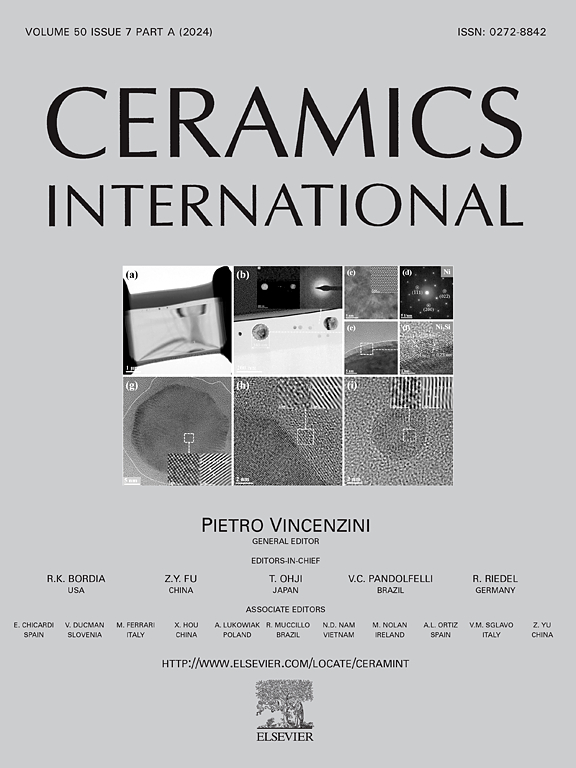3.46 μm中红外发射的无铅双钙钛矿氟玻璃和多波长阵列气体实时监测在氢能中的应用
IF 5.6
2区 材料科学
Q1 MATERIALS SCIENCE, CERAMICS
引用次数: 0
摘要
目前的工业制氢过程产生的氢气含有各种杂质,包括氯化氢和二氧化碳,这可能会影响其可用性。光学温度传感在氢能研究中起着至关重要的作用,特别强调光源发射波长与目标气体吸收波长相匹配的重要性。例如,3.4 μm波长对应于HCl气体的吸收,但文献中缺乏符合这一特殊要求的光源材料的报道。本研究的重点是探索一系列红外光源阵列,其发射波长与气体的吸收波长相匹配,特别强调3.4 μm波长,因为它与HCl气体吸收一致。目前报道的发光持续时间超过3 μm的例子有限。在这项工作中,Cs2AgIn1-xTmxCl6-ZBLAY钙钛矿氟化物玻璃发出3.46 μm的中红外发光,这是一个关键的发现,因为它与HCl气体在相同的3.4 μm波长上的独特吸收峰相吻合。利用第一性原理计算增强了对Cs2AgIn1-xTmxCl6的态密度和电子能带结构的理解。Cs2AgIn1-xTmxCl6-ZBLAY钙钛矿氟化玻璃,表明其作为未来中红外发射材料的潜力。该材料无毒,可发射波长为3.46 μm的中红外光,有望在红外成像、生物医学、气体检测等领域发挥重要作用。为此,设计了一种由Cs2AgIn1-xTmxCl6-ZBLAY、Cs2AgIn1-xErxCl6-ZBLAN和ZBLAN: Ho组成的多波长阵列气体实时监测装置。本文章由计算机程序翻译,如有差异,请以英文原文为准。
3.46 μm mid-infrared emission from lead-free double perovskite fluorine glass and multi-wavelength array gas real-time monitoring applications in hydrogen energy
The current industrial hydrogen production processes generate hydrogen gas containing various impurities, including hydrogen chloride and carbon dioxide, which may affect its usability. Optical temperature sensing plays a crucial role in hydrogen energy research, with particular emphasis on the importance of light sources emitting wavelengths that match the absorption wavelengths of the target gas. For instance, the 3.4 μm wavelength corresponds to the absorption of HCl gas, yet the literature lacks reports on light source materials that match this particular requirement. This study focuses on exploring a series of infrared light source arrays that emit wavelengths matching the absorption wavelengths of gases, specifically emphasizing the 3.4 μm wavelength as it aligns with HCl gas absorption. There have been limited instances of luminescent durations surpassing 3 μm reported. In this work, the Cs2AgIn1-xTmxCl6-ZBLAY perovskite fluoride glass emits mid-infrared luminescence at 3.46 μm, a key finding as it coincides with the distinctive absorption peaks of HCl gas at the same 3.4 μm wavelength. First-principles calculations were performed to enhance understanding of the density of states and electronic energy band structure of Cs2AgIn1-xTmxCl6. Cs2AgIn1-xTmxCl6-ZBLAY perovskite fluoride glass, indicating its potential as a future material for mid-infrared emission. It is non-toxic and emits mid-infrared light at a wavelength of 3.46 μm, which is expected to be useful in infrared imaging, biomedicine, gas detection and other applications. Therefore, a real-time gas-monitoring device with a multi-wavelength array using Cs2AgIn1-xTmxCl6-ZBLAY,Cs2AgIn1-xErxCl6-ZBLAN, and ZBLAN: Ho has been designed.
求助全文
通过发布文献求助,成功后即可免费获取论文全文。
去求助
来源期刊

Ceramics International
工程技术-材料科学:硅酸盐
CiteScore
9.40
自引率
15.40%
发文量
4558
审稿时长
25 days
期刊介绍:
Ceramics International covers the science of advanced ceramic materials. The journal encourages contributions that demonstrate how an understanding of the basic chemical and physical phenomena may direct materials design and stimulate ideas for new or improved processing techniques, in order to obtain materials with desired structural features and properties.
Ceramics International covers oxide and non-oxide ceramics, functional glasses, glass ceramics, amorphous inorganic non-metallic materials (and their combinations with metal and organic materials), in the form of particulates, dense or porous bodies, thin/thick films and laminated, graded and composite structures. Process related topics such as ceramic-ceramic joints or joining ceramics with dissimilar materials, as well as surface finishing and conditioning are also covered. Besides traditional processing techniques, manufacturing routes of interest include innovative procedures benefiting from externally applied stresses, electromagnetic fields and energetic beams, as well as top-down and self-assembly nanotechnology approaches. In addition, the journal welcomes submissions on bio-inspired and bio-enabled materials designs, experimentally validated multi scale modelling and simulation for materials design, and the use of the most advanced chemical and physical characterization techniques of structure, properties and behaviour.
Technologically relevant low-dimensional systems are a particular focus of Ceramics International. These include 0, 1 and 2-D nanomaterials (also covering CNTs, graphene and related materials, and diamond-like carbons), their nanocomposites, as well as nano-hybrids and hierarchical multifunctional nanostructures that might integrate molecular, biological and electronic components.
 求助内容:
求助内容: 应助结果提醒方式:
应助结果提醒方式:


